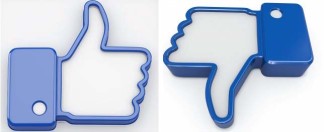
Facebook uses a proprietary algorithm, known as EdgeRank, to determine which posts show up in a user’s News Feed. The EdgeRank algorithm basically sorts through all the content posted by a user’s connections, and then offers up those posts that it deems relevant. Researchers estimate that, on average, only about 17 percent of posts from friend and fan pages show up in a user’s News Feed, and Facebook has revealed that the average post from a brand page only reaches 16 percent of fans.
Fortunately, the situation isn’t as dire as it sounds. With a little effort and persistence, you can give your content the boost it needs to bubble up past those adorable baby pictures and ill-informed political rants that currently dominate your customers’ News Feeds. The key is understanding just how EdgeRank works.
Facebook’s EdgeRank… It’s Science!
The EdgeRank algorithm is the sum of edges, where each edge is determined by multiplying User Affinity (U) by Weight (W) by Time Decay (D). Or in other words…

If you understood all that, let me be the first to congratulate you on your mathematical acumen. If not, don’t worry. It might seem complicated, but the underlying principles are surprisingly simple.
What Is an Edge?
Basically, anything you can do in Facebook is known as an edge. Updating your status, uploading photos, liking, commenting, and sharing are some of the most common edges that you might use to interact with your friends and fans. When determining how important an edge is for a given user, EdgeRank considers three criteria.
User Affinity
User Affinity is a measure of the relationship between your Page and another Facebook user. If a user interacts frequently with your Pages posts, then your posts will be more likely to show up in that user’s News Feed. If someone who has “liked” your Page never interacts with your updates, then your posts will seldom (if ever) crop up. User Affinity also measures the type of content you prefer. So if you tend to respond to videos more than anything else, you’ll see more videos in your News Feed.
But before you start spamming comments and likes in the hopes of building up EdgeRank with your customers, you should understand that User Affinity only goes one way. If you’re active on someone else’s page, then their content will be more likely to show up in your News Feed. However, for your content to show up in theirs, they need to be interacting with you on a regular basis.
Weight
Facebook assigns different edges a Weight value, with higher weights resulting in higher EdgeRank scores. In general, Weight is determined by:
- Action Type. The more effort an action requires, the higher it is weighted. For example, posting a photo or video is worth more in terms of weight than posting an ordinary status update.
- Engagement from Other Users. Actions that generate a lot of user response will carry more weight than actions with little or no response. For example, an ordinary status update that garners likes and comments will likely outweigh a video or photo that gets no response.
- Negative Feedback. The more complaints or negative feedback a post receives, the less likely it is to show up in your News Feed.
- New Features. When Facebook introduces a new feature, they’ll often assign it a higher Weight to encourage folks to use it. This means you’ll actually improve your odds of reaching more customers by using newer features to engage them.
Time Decay
Time Decay is simply a measure of how long it’s been since the edge (or action) was performed. The actual value of time delay is 1/(time since action), which means the value will continue to decrease over time.
Put Them All Together…
So Facebook multiplies User Affinity by Weight by Time Decay to come up with a numeric value for each edge, and then adds up all of the edges to determine the EdgeRank value for each of your connections. Those with a higher EdgeRank will show up more frequently in your News Feed. And if you have a significant EdgeRank with regards to your friends and/or fans, they’ll be more likely to see your posts.
Improving Your EdgeRank
There are no silver bullets or quick fixes when it comes to improving your EdgeRank with your customers. The only way to show up in their News Feeds is to consistently provide content that they’ll want to read, like, and share.
- Be concise. Keep your posts between 100 and 250 characters.
- Be consistent. Try to post every day, but don’t overdo it. Too many posts can be just as detrimental as too few.
- Be relevant. Keep your posts on-topic, but make sure to keep the self-promotion to a minimum.
- Be timely. The best time to post is when your customers are online and ready to respond. A post at 8pm will probably get more response than one at 4am.
- Be visual. Not only do photos and videos carry more weight, they tend to draw more engagement than other types of Facebook content.


